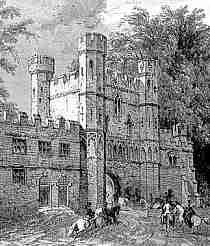
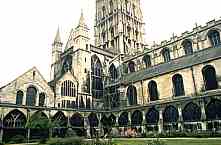
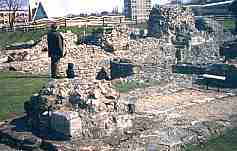
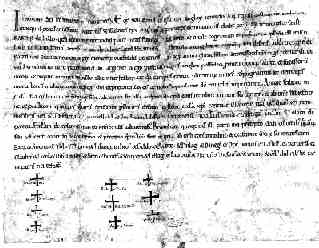
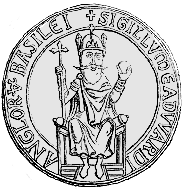
If you are looking at this page without frames, there is more information about medieval writing to be found by going to the home page (framed) or the site map (no frames).
| Forged Charters | ||||||
| It might seem a little peculiar to devote a section to documents which are not genuine. However, most forged medieval charters are genuinely medieval. There has been no great industry producing fake charters for the art or antiquities market. In fact, the term forgery is rather severe for this class of document, which might be more accurately termed a retrospective charter. They are significant in the history of writing and literacy as they testify to a huge change in the significance of the written word in government and administration, and perhaps also of the charter itself as a material object. | ||||||
| Further information on this subject can be obtained from Bishop and Chaplais 1957 also Clanchy 1993 also Searle 1968. | ||||||
| A significant proportion of early charters and writs, from before or shortly after the Norman Conquest of England, have been found to be forgeries. The forgeries are found as entries in cartularies, and also as original single sheet documents, complete with forged copies of the great seal. They were evidently produced by or for the institutions, such as monasteries, which were the beneficiaries of the provisions of the charter. Many were produced around the 12th century. The reasons why good men of the church should indulge in behaviour which we might now consider to be a trifle deceitful, if not downright dishonest, are based in the feudal system and the relationship of the church and state, as well as the changing significance of the written word. |
 |
|||||
| The gatehouse of Battle Abbey, an institution which had a series of forged charters. | ||||||
 |
Huge and magnificent complexes that were enlarged and beautified over the centuries, like Gloucester Abbey, were not provided by the angels. | |||||
| A major necessity for a monastic community was land; not just space to build on and areas for Brother Cadfael-like figures to tend their herb gardens, but economically functioning rural communities over which they could exercise the rights of feudal landlords. Along with this went the right to levy certain tolls and charges and to exercise justice without interference from the king's officers. Tithes from parish churches granted to the abbeys also contributed. These all funded not only their basic necessities of life, but ambitious programs of building, the amassing of libraries, the collection of treasures dedicated to the glory of God and the saints, and of course, charitable care for the poor and sick. Royal grants were made in perpetuity through the medium of charters, meaning that once given it could not be taken away, provided that everybody remembered. | ||||||
| Latin diplomas and vernacular writs were is use in England before the Norman Conquest to verify royal grants and establish title to land, but these were material tokens of what was essentially an oral process. Witnesses to documents could provide sworn testimony as to the contents of a grant. The ownership of privilege was passed down by tradition. The reading aloud of a document in a public place was probably more significant to its ratification than preservation of the piece of parchment that it was written on. Furthermore, there was no systematic archiving of the documents at the royal end. The word as spoken had priority over written text. | ||||||
 |
||||||
| This did not change abruptly at the Norman Conquest, except that for institutions of Anglo-Saxon foundation, there was a necessity to ensure that privileges granted were ratified by the new regime. However, during the course of the 12th century it evidently became more significant to possess the written evidence for legal privileges. This could be a bit of a problem if somebody had inconveniently misplaced it, or if it had never been presented in written form, the king having made a magnanimous public declaration on some auspicious occasion. | ||||||
| Institutions like St Augustine's Abbey in Canterbury were founded long before written authentication of privilege was considered essential. | ||||||
| The most benign interpretation of these forged charters is that they were bookkeeping exercises, simply regularising what was known to be the truth. Traditional knowledge and oral testimony were simply transferred into this newfangled system of archiving the written word. The easiest way to do it was simply to add the appropriate entries to a cartulary, putting in the most appropriate form of words for what had been lost or had never actually existed in written form. A rather grander, and to us more dubious, procedure was to emulate the original form of the charter, complete with seal. | ||||||
 |
A forged charter of Battle Abbey (British Library, Egerton Charter 2211), by permission of the British Library. | |||||
| The seal is not shown here, but it is a forgery. The charter purports to be of William II confirming all privileges granted by his father William I, founder of the abbey. It actually dates from the mid 12th century. | ||||||
| It was not always simply grants of land that were at stake. Sometimes special privileges were claimed, or there were disputed privileges between interested parties, and this is where a forged charter might be used to boost the arguments of one side between competing claimants. The forged charter illustrated above has a clause claiming that the abbey was exempt from any overriding authority from bishops. This relates to a long dispute that the abbey had with the bishop of Chichester. There may have been a bit of monastic duplicity here, or perhaps they were just stating the case as they saw it. | ||||||
| The vernacular writ was a new form of charter, different in type from the pre-existing Latin diploma, introduced probably in the reign of Edward the Confessor. Certainly the greatest number survive from his reign, of which a large proportion, possibly about half, are forgeries. One explanation for this is that the forgeries were needed to ratify claims after the Norman Conquest. Despite the Battle of Hastings and an individual named Harold, William I claimed to be the legitimate successor to Edward the Confessor, so the Norman dynasty should have cast a benign eye over privileges granted by this predecessor. An associated supposedly Edwardian invention was the great seal. This was the authentication for the document. |  |
|||||
| The great seal of Edward the Confessor, drawn from a forgery. | ||||||
|
|
||||||
|
If you are looking at this page without frames, there is more information about medieval writing to be found by going to the home page (framed) or the site map (no frames). |
||||||